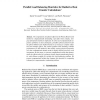Free Online Productivity Tools
i2Speak
i2Symbol
i2OCR
iTex2Img
iWeb2Print
iWeb2Shot
i2Type
iPdf2Split
iPdf2Merge
i2Bopomofo
i2Arabic
i2Style
i2Image
i2PDF
iLatex2Rtf
Sci2ools
99
Voted
CSC
2006
2006
Parallel Load Balancing Heuristics for Radiative Heat Transfer Calculations
The computation of radiative effects by the Photon Monte Carlo method is computationally demanding, especially when complex, nongray absorption models are employed. To solve such computationally expensive problems we have developed a parallel software framework for the photon Monte Carlo method based on ray tracing to compute radiative heat transfer effects. The central problem with obtaining scalable performance for this method is that widely varying physical properties over the computational domain result in highly skewed processor work assignment. In this paper we present computational results that demonstrate the effectiveness of a geometry based, domain partitioning heuristic with element weights for solving this load balancing problem. We present computational results that compare this heuristic to competing schemes for a representative combustion problem.
| Added | 30 Oct 2010 |
| Updated | 30 Oct 2010 |
| Type | Conference |
| Year | 2006 |
| Where | CSC |
| Authors | Kamal Viswanath, Ivana Veljkovic, Paul E. Plassmann |
Comments (0)

